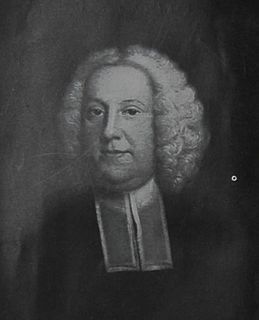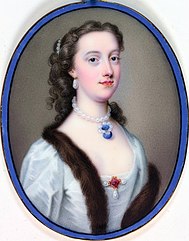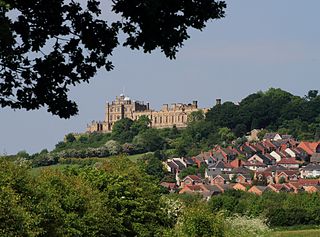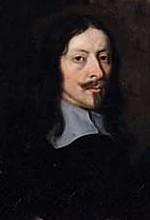
Thomas Hobbes was an English philosopher, considered to be one of the founders of modern political philosophy. Hobbes is best known for his 1651 book Leviathan, in which he expounds an influential formulation of social contract theory. In addition to political philosophy, Hobbes contributed to a diverse array of other fields, including history, jurisprudence, geometry, the physics of gases, theology, and ethics, as well as philosophy in general.

Margaret Lucas Cavendish, Duchess of Newcastle-upon-Tyne was an English philosopher, poet, scientist, fiction writer and playwright. Being related to royalists, she spent some of the English Civil War in France. She wrote in her own name in a period when most women writers remained anonymous.

William Cavendish, 1st Duke of Newcastle upon Tyne, KG, KB, PC was an English courtier and supporter of the arts. He was a renowned horse breeder, as well as being patron of the playwright Ben Jonson, and the intellectual group known as the Welbeck Circle.
This article contains information about the literary events and publications of 1667.
This article contains information about the literary events and publications of 1645.

William Cavendish, 1st Duke of Devonshire, was an English soldier, nobleman, and Whig politician who sat in the House of Commons from 1661 to 1684 when he inherited his father's peerage as Earl of Devonshire. He was part of the "Immortal Seven" group that invited William III, Prince of Orange to depose James II of England as monarch during the Glorious Revolution, and was rewarded with the elevation to Duke of Devonshire in 1694.

John Pell was an English mathematician and political agent abroad.
Sir Noel Robert Malcolm, is an English political journalist, historian and academic. A King's Scholar at Eton College, Malcolm read history at Peterhouse, Cambridge, and received his doctorate in history from Trinity College, Cambridge. He was a Fellow and College Lecturer of Gonville and Caius College, Cambridge, before becoming a political and foreign affairs journalist for The Spectator and the Daily Telegraph.

John Holles, 1st Duke of Newcastle-upon-Tyne, KG, PC was an English peer.

Henry Cavendish, 2nd Duke of Newcastle-upon-Tyne, KG, PC, styled Lord Cavendish until 1676, and Viscount Mansfield from 1676, was an English politician who sat in the House of Commons from 1660 to 1676, and then inherited the dukedom.

Margaret Cavendish Bentinck, Duchess of Portland was a British aristocrat, styled Lady Margaret Harley before 1734, Duchess of Portland from 1734 to her husband's death in 1761, and Dowager Duchess of Portland from 1761 until her own death in 1785.

The Description of a New World, Called The Blazing-World, better known as The Blazing World, is a 1666 work of prose fiction by the English writer Margaret Cavendish, the Duchess of Newcastle. Feminist critic Dale Spender calls it a forerunner of science fiction. It can also be read as a utopian work.

Sir Charles Cavendish was an English aristocrat, Member of Parliament for Nottingham, and patron.
Walter Warner (1563–1643) was an English mathematician and scientist.
George Aglionby (c.1603–1643) was an English Royalist churchman, nominated in 1643 as Dean of Canterbury. He was a member of the Great Tew intellectual circle around Lucius Cary, and a friend and correspondent of Thomas Hobbes.

Christian(a) Cavendish, Countess of Devonshire (1595-1675) was an influential Anglo-Scottish landowner and royalist.
The Battle of Leeds took place during the First English Civil War on 23 January 1643, when a Parliamentarian force attacked the Royalist garrison of Leeds, Yorkshire. The attack was partly dictated by the need to maintain local support for the Parliamentarian cause; the Earl of Newcastle had recently shifted the balance of power in Yorkshire in the Royalists' favour with the addition of his 8,000-strong army, and sent one of his commanders, Sir William Savile to capture Leeds. The West Riding of Yorkshire relied on the cloth trade, and Ferdinando, Lord Fairfax sent his son, Sir Thomas Fairfax to bolster the defences of nearby Bradford, before agreeing to his request to attack Leeds.
The Great Tew Circle was a group of clerics and literary figures who gathered in the 1630s at the manor house of Great Tew, Oxfordshire in southern England, and in London.
Robert Payne (1596–1651) was an English cleric and academic, known also as a natural philosopher and experimentalist. He was associated with the so-called Welbeck Academy by his position as chaplain to William Cavendish, 1st Earl of Newcastle. The position also brought him a close friendship with Thomas Hobbes.
William Burdon (1764–1818) was an English academic, mineowner and writer.













